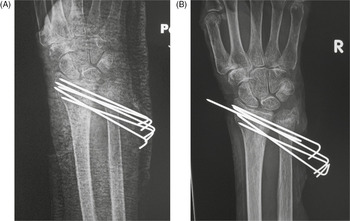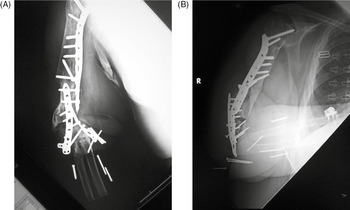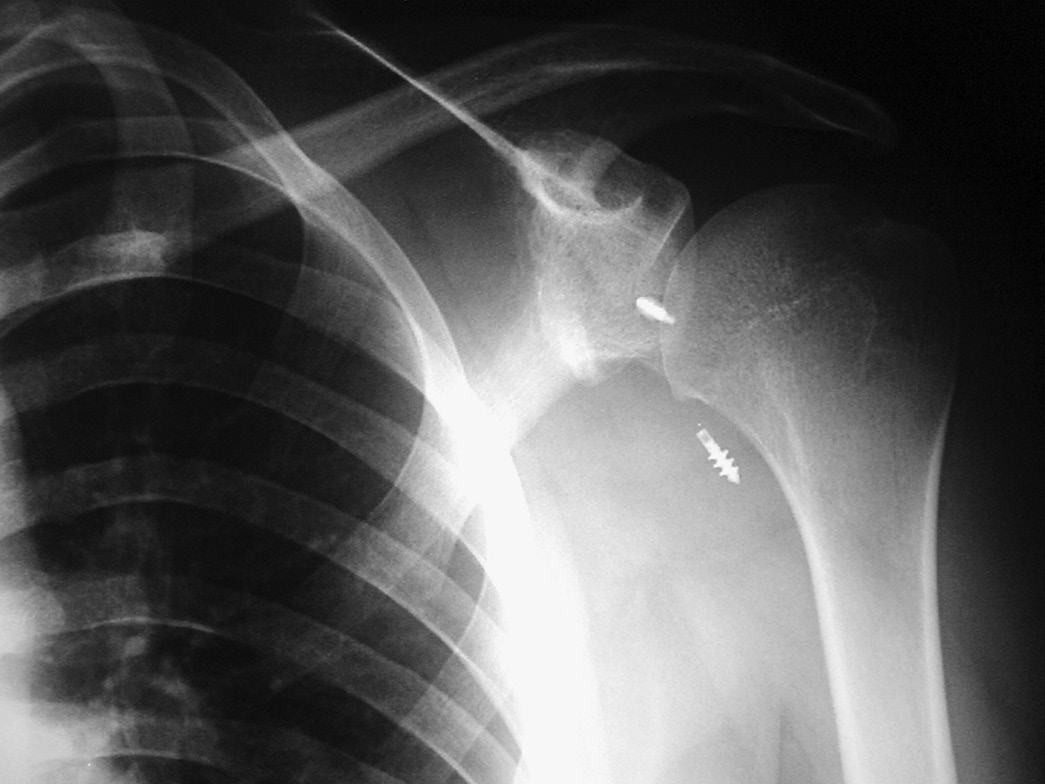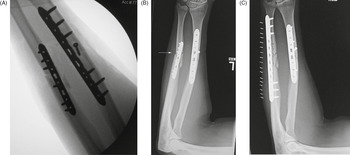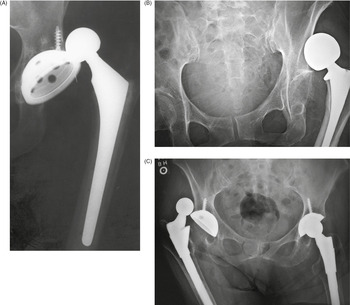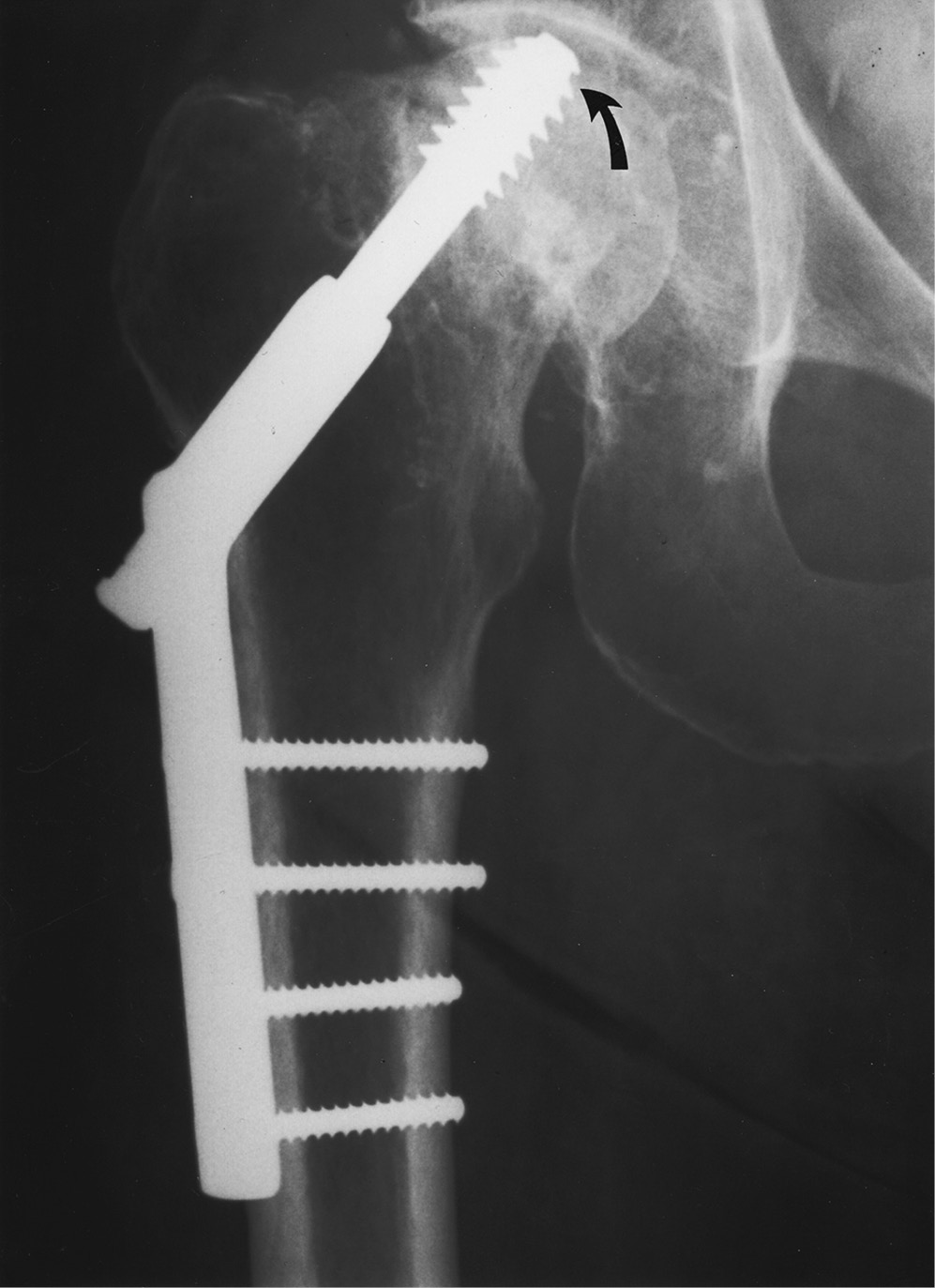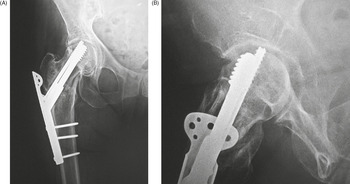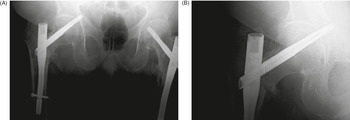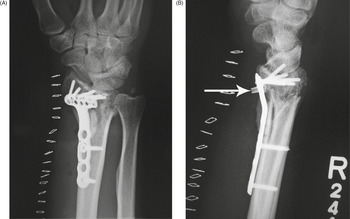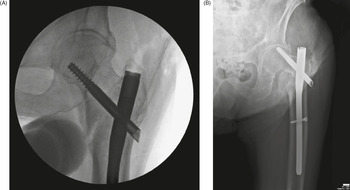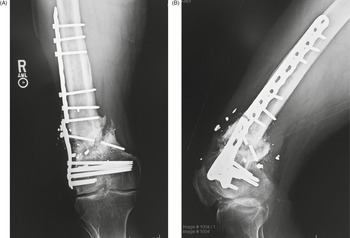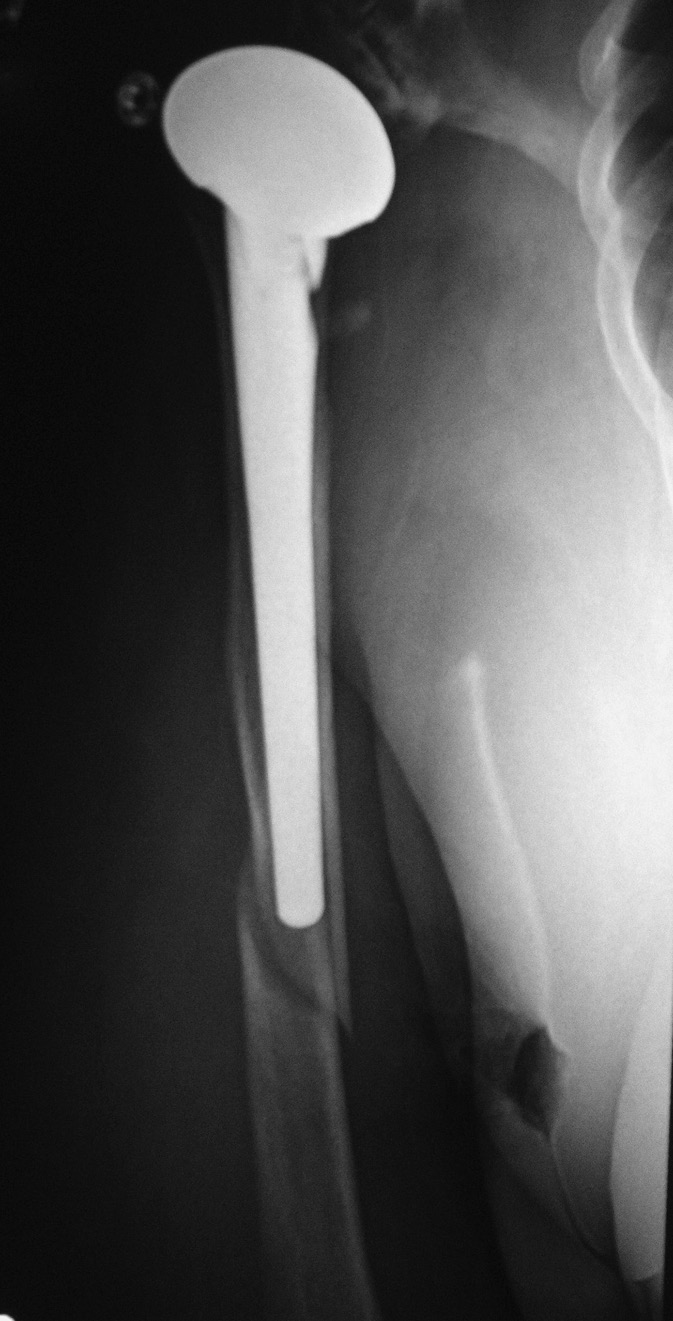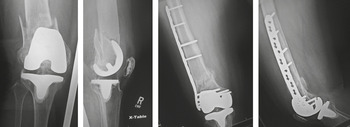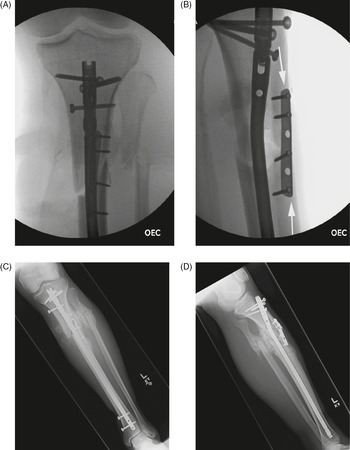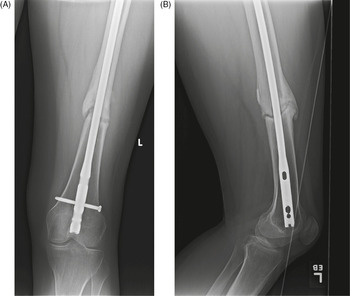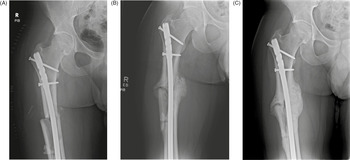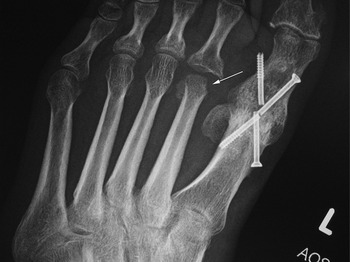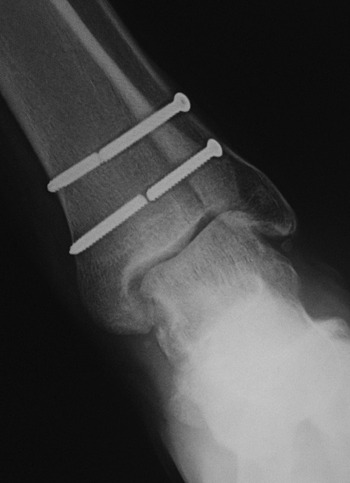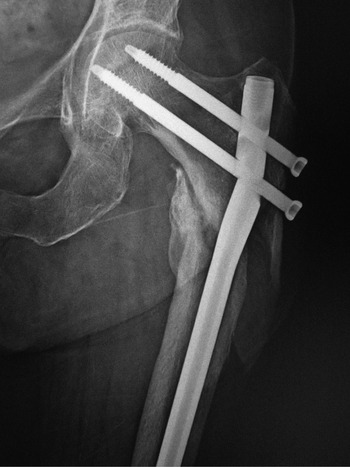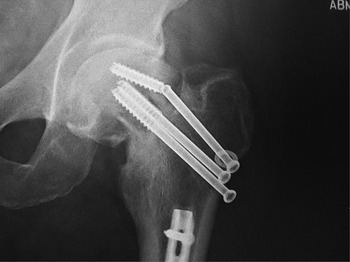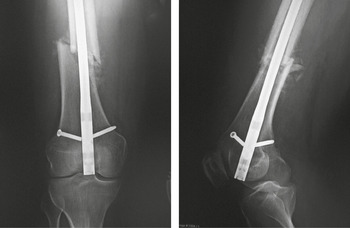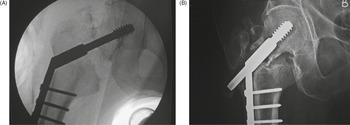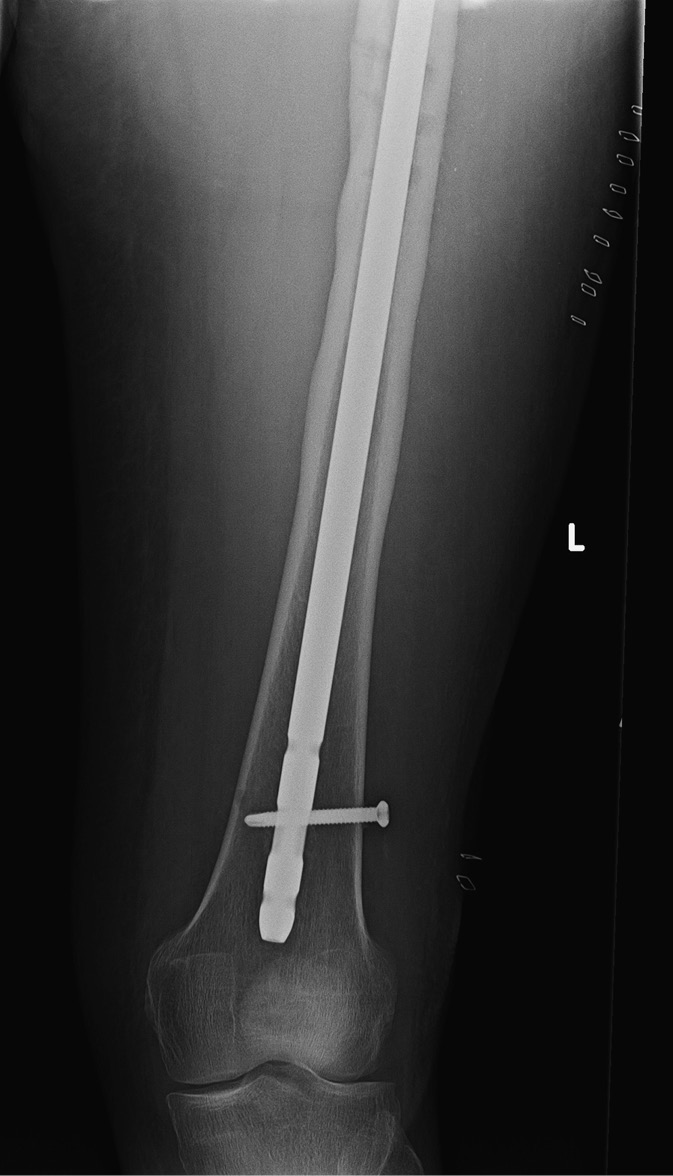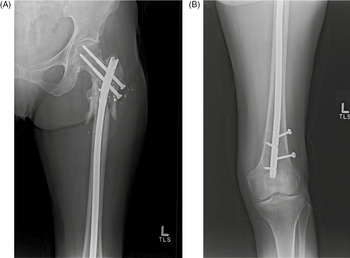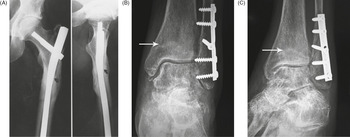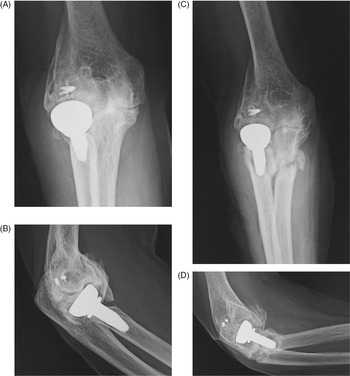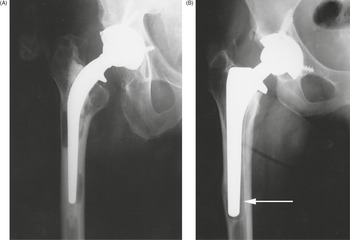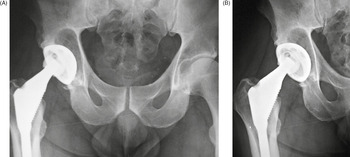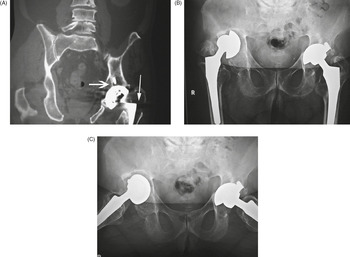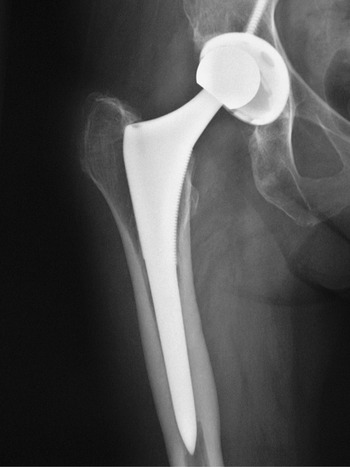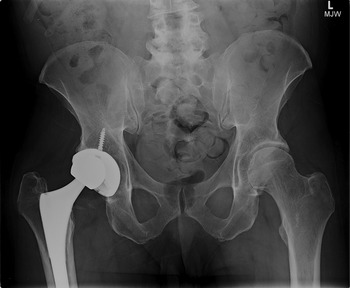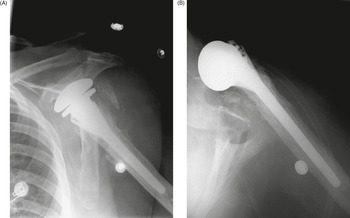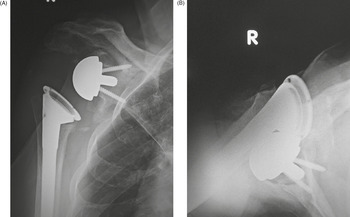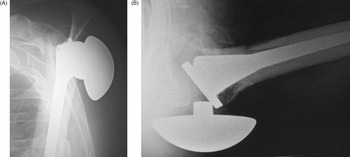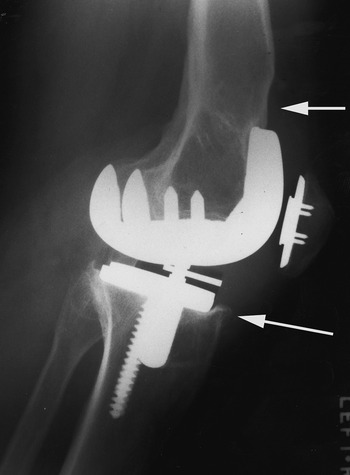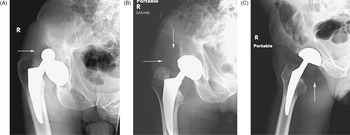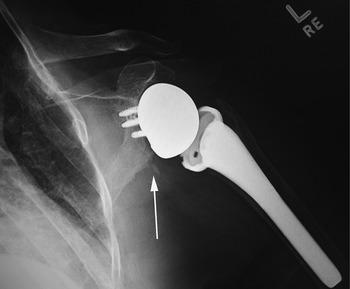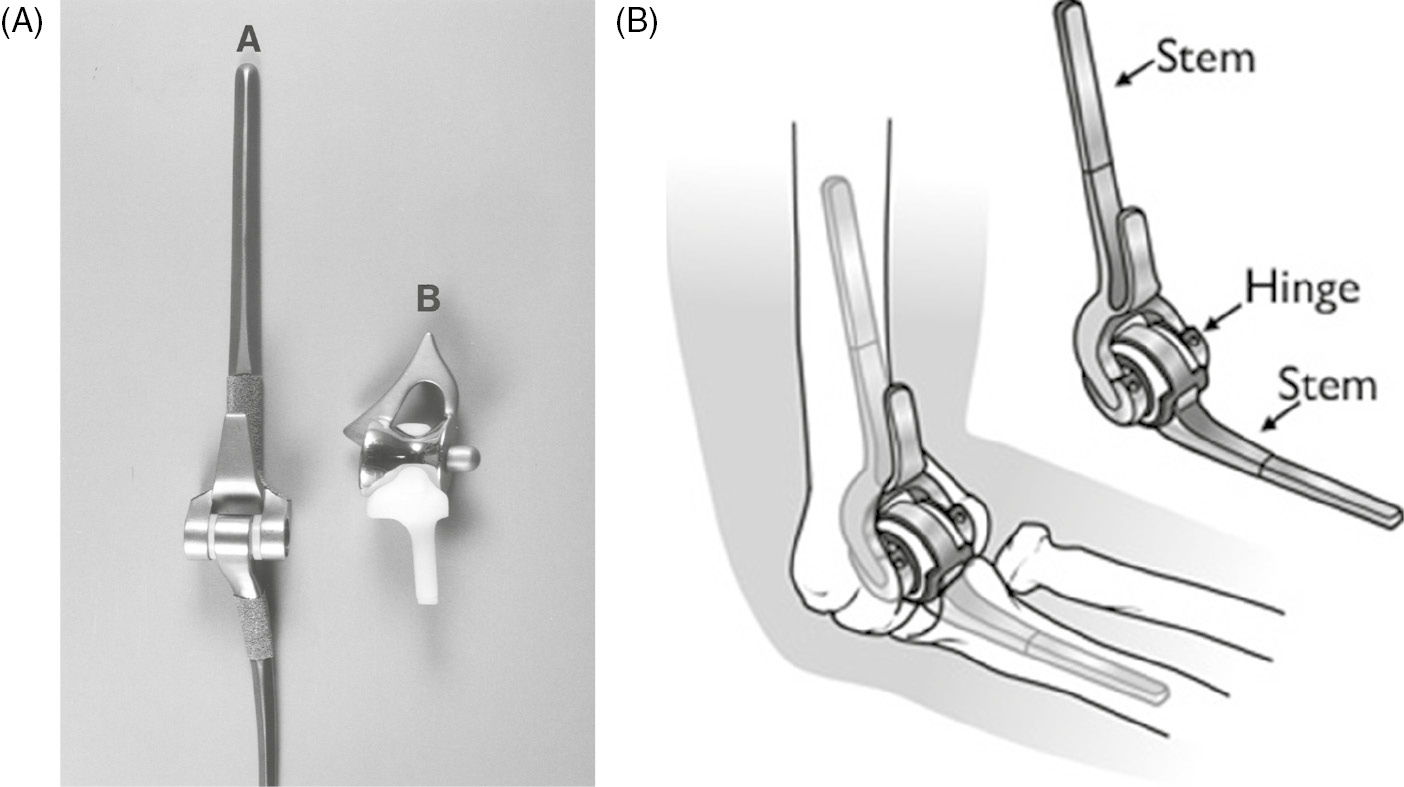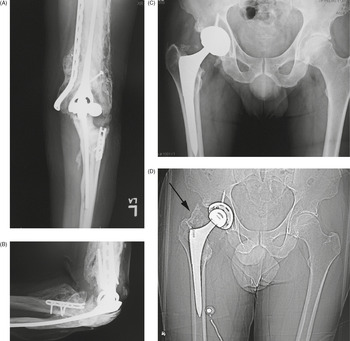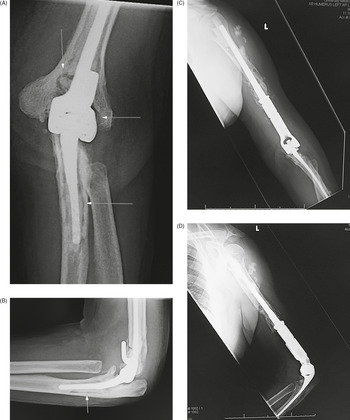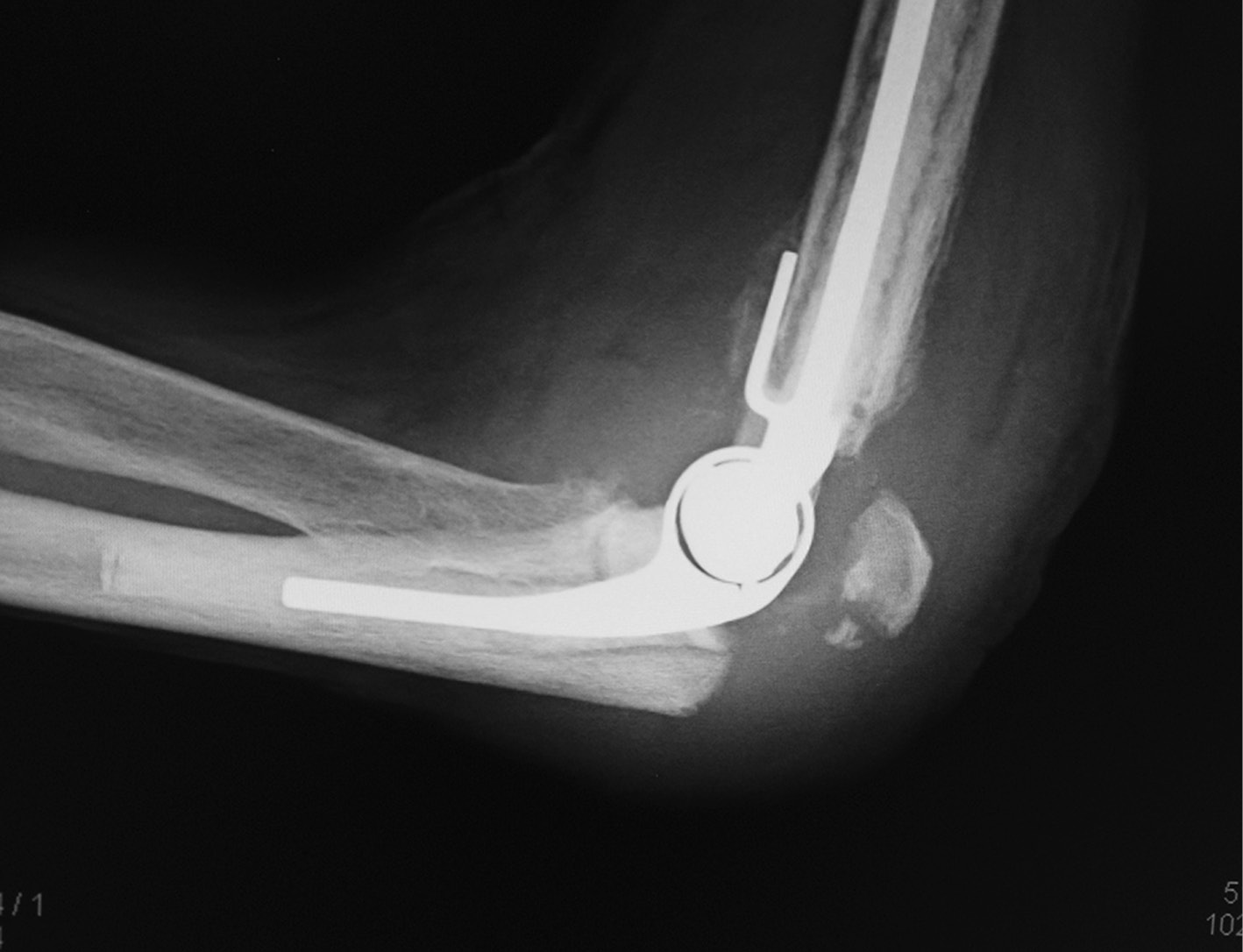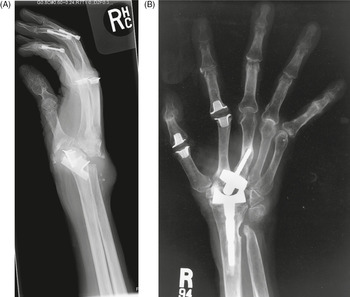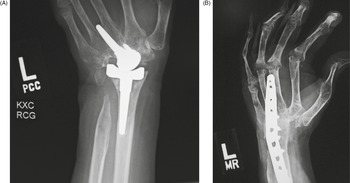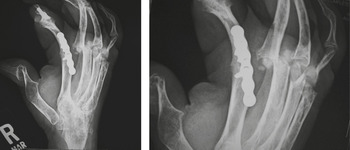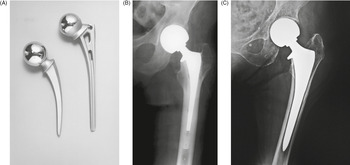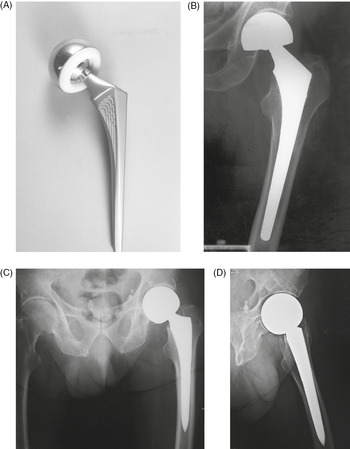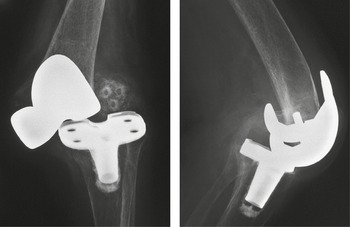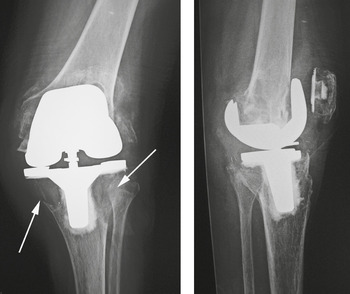Introduction
The use of orthopedic devices can sometimes be life-saving. More often, they significantly reduce pain and discomfort while restoring mobility and improving one’s sense of well-being. Nevertheless, all medical devices no matter the type or intended use – intravenous lines, prosthetic heart valves, cerebrospinal fluid shunts, pacemakers, fracture fixation plates, joint arthroplasties – are subject to malfunction and complications. These fortunately are rare and usually recognized appropriately. However, one should always carefully examine every imaging study for possible device complications so they may be addressed in a timely fashion.
There are generic complications that can be found with almost any piece of medical equipment placed on or inside the body for patient monitoring or treatment. These include incorrect device location, device malfunction, device breakage with displacement into adjacent tissues, device breakage with embolization to distant sites as well as device-caused vascular and nervous system injury or device-induced localized infection with cellulitis, abscess formation, or generalized sepsis (Hunter & Bragg, 1994).
Orthopedic apparatus also may be subject to particular complications that are derived from the location or the intended application of a specific device. These complications vary considerably from increased spinal degenerative disease above the level of spinal fixation apparatus to particle wear disease in a joint arthroplasty.
Fracture fixation apparatus – wires, rods, nails, plates, and screws – are a major part of everyday orthopedic practice, and their complications are frequently evident on radiographs. Many of these “complications” are minor and of no consequence. The most common example is the fracturing of fixation screws. These are frequently incidental findings, but their significance obviously depends on their location and intended use (Benjamin & Lund, 1994).
These plates, rods, or screws may be malpositioned iatrogenically, or they can bend, break, or migrate, becoming displaced. The bone around these implants can fail with a fracture, potentially related to stress from the implant. All implants have the risk of becoming infected, which may necessitate implant removal and treatment of the infection. While complications associated with fracture fixation are uncommon on a percentage basis, they are frequent in a busy practice situation, because fracture fixation is so common.
Joint arthroplasty complications are somewhat less common because joint arthroplasty is not as frequently performed as fracture fixation. However, hip, knee, and shoulder joint replacement is very common, and practices with a large number of patients with joint prostheses can expect to see displaced, broken, or dislocated prostheses from time to time. Joint prostheses can become infected, which may be difficult to diagnose by imaging, and their joint liners can have excessive or uneven wear producing improper joint functioning or a severe granulomatous reaction (particle disease).
The present discussion provides an overview of those complications, common and uncommon, associated with orthopedic devices of the extremities, joints, and pelvis. The discussion is extensive but by no means exhaustive, and one is encouraged to also review the attached references. In addition, a pictorial Gallery of Complications provides a quick reference for reviewing many of the complications that can be associated with orthopedic apparatus. In all cases, every patient radiograph, cross-sectional image, or nuclear medicine image should be examined carefully for the presence of medical apparatus. Ideally, the type of apparatus, its proper placement and function, and any complication should be noted. The presence of any significant complications should be rapidly conveyed to the patient’s physicians.
Implantable orthopedic devices have been used since the early twentieth century for treatment of skeletal maladies. Modern treatment of orthopedic diseases including fractures, degenerative diseases, and other deformities involves the use of metallic and non-metallic implants. Over the last century, significant advances have been made not only to the implants themselves, but the techniques and methods in which they are used. Ever since the first orthopedic devices were implanted, complications have been noted (Ruedi et al., 2007).
Fixation
Most orthopedic implants require fixation into bone or soft tissue for stability and function. This fixation is achieved in several ways. The most basic fixation relies upon friction fitting. Smooth wires (Kirschner wires or K-wires) are spun into the bone and, once in place, friction between the wire and the bone holds them in place (Althausen & Hak, 2002; Jauregui et al., 2015; Ruedi et al., 2007).
Screws are commonly used orthopedic implants and can function independently or as part of a construct. Screws can function in many different ways, either by design, or by the method in which they are applied. They can serve as a simple anchor for attaching objects such as suture, tendons, or plates to bone. They can be used independently, as a means to compress or maintain position of a fracture (Benjamin & Lund, 1994). At the functional level, screws also rely upon friction between the threads and the bone to achieve stability. When used with a plate, the screws themselves compress the plate to the bone surface. Once tightened, the plate is kept in place and motion is prevented by friction between the undersurface of the plate and the bone (AAOS, 2008).
The use of a wedge is another way implants exploit friction for their attachment to bone. The most common example of this is a tapered hip prosthesis, where the device is wedged into the proximal femur to achieve stability. As the implant is loaded, it further compresses the implant/bone interface. Some of these implants are designed to then allow bone to in-grow and attach directly to the prosthesis – using a porous surface, and sometimes a hydroxyapatite coating that allows for a molecular level attachment to the bone.
Cement is another option for fixation. Cement is usually pressurized or pushed into the trabecular bone, where it interdigitates to achieve “purchase” into the bone at the cement–bone interface. The implant is then placed into the cement “mantle” before the cement hardens creating a perfectly conformed fit between the cement and the implant. This cement–implant interface relies upon a friction fit for stability.
Other devices such as buttons and anchors are also used to attach sutures or soft tissue to bone and are designed to resist tensile forces.
Finally, some devices do not achieve rigid fixation to the bone. Intramedullary nails, for example, are placed within the medullary cavity. They are often held in position by interlocking screws. While the screws have stability in the bone, the interface between the screws and the nail has a considerable degree of tolerance allowing for macroscopic motion of the nail and thus macroscopic motion at the fracture site.
Device Failure
Orthopedic devices, like any mechanical object, can fail in many ways (Benjamin & Lund, 1994; Berquist, 1995; Freiberg, 2001; Gelman, 1984). The implant itself may fail by breakage, or the bone–implant interface may fail with loosening or fracture (Figures 5.1, 5.2, 5.3, and 5.4).
Figure 5.1 Migration of fracture fixation pin. (A) Elderly woman with distal radius fracture stabilized by multiple fixation pins (K-wires). (B) Three weeks later one of the K-wires has become displaced extending through the radius and skin.
Figure 5.2 Plate loosening and screw displacement. 39-year-old woman with poorly healing complex proximal and distal humerus fractures. The bicondylar distal humerus fixation plates have become loosened with displacement of multiple screws into the soft tissues of the right arm and forearm.
Figure 5.3 Displaced humeral head suture anchors.
Figure 5.4 Failed low contact dynamic compression (LCD) plate. 48-year-old man with left comminuted mid-shaft radius and ulna fractures. An immediate postoperative radiograph (A) shows placement of LCD plates in both the radius and ulna. Follow-up radiograph (B) two weeks later shows mild angulation at the ulnar plate (arrow). At revision surgery the ulnar plate had failed and come loose from the ulna. The radial plate was intact. A long revision LCD plate was placed in the ulna (C). Skin staples are visible next to the revised ulnar plate.
Prosthetic joints are subject to loosening, wear, and dislocation (Figure 5.5). Failure can also occur iatrogenically through improper or inappropriate placement (Figures 5.6–5.10).
Figure 5.5 (A) Posteriorly dislocated left hip arthroplasty. (B) Left hip unipolar prosthesis posterior dislocation. (C) Bilateral total hip arthroplasty with right hip dislocation.
Figure 5.6 Fixation screw projecting into right hip joint. The compression screw has slid distally in the barrel as it was designed to do when the femoral neck fracture site becomes compressed. This did not prevent the screw from cutting out of the femoral head (curved arrow).
Figure 5.7 60-year-old woman treated for right hip intertrochanteric fracture with lateral stabilizing trochanter plate, dynamic compression screw, and separate cannulated fixation screw which extends into the right hip joint.
Figure 5.8 There are bilateral short femoral nails with helical femoral neck screws. The screw on the right has penetrated the right acetabulum.
Figure 5.9 Frontal (A) and lateral (B) views of the right wrist after placement of a volar T-plate and screws for a comminuted distal radius fracture. On the lateral view (B) there is a retained drill guide (arrow) that was inadvertently left in place. It should have been removed at the end of the surgical procedure. It is not evident on the AP view and was initially overlooked by both an MSK radiologist and the patient’s orthopedic surgeon.
Figure 5.10 Iatrogenic fracture fixation failure. (A) Intraoperative fixation of an intertrochanteric fracture demonstrates a cephalomedullary device with the tip of the cephalic screw positioned too short and very inferior in the neck (very large tip–apex distance). (B) Subsequent fracture fixation failure observed as the head and neck segment of the femur flexed 90 degrees with cut-out of the screw approaching the hip joint.
Lastly, the bone can fail around orthopedic implants, often termed periprosthetic or peri-implant failure (Figures 5.11–5.13). The causes of failure are multifactorial and may involve such patient factors as non-compliance, infection, and poor bone quality; or, they may simply be related to everyday mechanical factors such as normal wear and tear or excessive use with increased wear and tear (Figure 5.14).
Figure 5.11 36-year-old man with bullet wound in 2003 complicated by femur fracture infected non-union treated by multiple attempts with external fixation and open reduction and internal fixation (ORIF). Radiography 12 years later shows chronic fracture hypertrophic nonunion, multiple shrapnel fragments, and breakage of a periarticular fixation plate.
Figure 5.12 51-year-old woman with right shoulder prosthesis periarticular fracture.
Figure 5.13 Right femur supracondylar periprosthetic fracture treated with lateral periarticular locking plate. 74-year-old women who was in an automobile accident and suffered a right femur supracondylar periprosthetic fracture about her posterior cruciate-retaining TKA. The fracture was treated with a lateral periarticular locking plate and screws.
Figure 5.14 Male patient with proximal tibia and fibula fractures treated by intramedullary nail and supplemental one-third tubular plate. Initial intraoperative fluoroscopic AP and lateral images (A,B) show the plate (arrow on lateral image). The patient ambulated against advice and was lost to follow-up. Two months later he again presented (C,D) to the clinic. There is now tibia fracture migration, and the proximal medial to lateral interlocking screw has backed out (AP view). The lateral view demonstrates fracture displacement with flexion deformity. The nail has troughed outside the proximal anterior tibia and is sitting within the soft tissues. The supplementary plate is broken, there is a broken interlocking screw, and abundant fracture callus is present.
In general, orthopedic implants are more rigid than the bone to which they are fixed. The “quality” or density of the bone is tied directly to the fixation strength of most orthopedic implants. Any loss of bone quality can negatively affect their purchase. Location of the implant can also play a factor because bones are anisotropic and not uniformly dense throughout their length. As diaphyseal bone is far thicker and denser than metaphyseal bone, an implant which achieves fixation in diaphyseal bone may have stronger fixation than an identical implant placed in the thinner metaphysis or epiphysis.
Radiographic detection of implant failure may be obvious or very subtle. When devices themselves break, a radiographic view parallel to the failure plane may be necessary to detect the failure. When failure occurs between the bone and the device, the findings may be more difficult to detect. Healthy bone is in a dynamic state of turnover, and over time it responds to stress by laying down more bone in these areas of high stress according to Wolff’s law.
Orthopedic implants can change the forces the bone experiences, and therefore bone may change in response to the presence of an implant. An example is when an implant reduces thestress on a bone leading to a relative osteopenia, termed “stress shielding.” This unique ability of bone to adapt to loads under which it is placed can give radiographic clues as to the status of the bone–implant interface and possibly to the state of fracture healing. Detecting these changes as well as signs of loosening or failure of orthopedic implants may be difficult, so chronological comparison of radiographs is imperative.
Complications of Fracture Fixation
Fracture Treatment
Several types of orthopedic implants are used in the treatment of fractures – Wires (K-wires, Steinmann pins, Rush rods, Ender nails, flexible nails, cables; intramedullary (IM) rods/nails); Screws (cancellous, cortical, lag, cannulated, headless, interlocking); and Plates (tubular, reconstruction, compression, locking, blade) – to name the more common examples. These are discussed and illustrated in more detail in Chapter 3.
The principle goal of fracture treatment is restoring length, alignment, and rotation of the fracture, and maintaining it until the fracture heals (Ruedi et al., 2007). This can be performed with splinting or casting or through surgical fixation. Healing occurs either primarily or secondarily through a cartilage intermediate. Fractures involving the joint surface usually require anatomic reduction and stable fixation to prevent arthritis and to allow for early motion of the joint to preserve mobility and cartilage health (Muller, 1965).
Direct or primary bone (fracture) healing occurs when absolute stability is maintained after an anatomic reduction is achieved, and the fracture ends are compressed together. Direct bone healing requires there be no gap or motion at the fracture site. In this mode of bone healing, the standard bone turnover process continues as if no fracture is present. The fracture heals directly with new bone formation. The hallmark of this type of healing is the fracture line disappearing without the formation of callus.
Indirect or secondary bone (fracture) healing occurs through a cartilage intermediate. Motion at the fracture site creates a micro-environment which causes healing to proceed through several phases: (a) inflammation, (b) soft callus formation which is predominated by cartilage that helps reduce the motion/strain at the fracture, allowing for bone deposition with (c) transition to hard callus formation, and finally (d) bony remodeling.
Non-union
Non-union of a fracture is considered when 6 months have passed and the fracture has not healed, or if three consecutive radiographs show no progression towards healing. Non-unions can be divided radiographically into three main types: oligotrophic, atrophic, and hypertrophic. Each of these occurs in response to a unique environment. Detection of nonunion can be challenging. The use of dynamic radiographs, oblique views, and advanced imaging can aid in diagnosis.
Oligotrophic non-union often occurs when the bone has been devitalized, either by soft-tissue injury which occurred during the fracture, or iatrogenic insult caused during the surgery. Because the blood supply has been damaged, the fracture is frozen in time without resorption or progress towards healing. Often patients are non-weight-bearing, which causes the surrounding viable bone to undergo relative atrophy or resorption according to Wolff’s law. This leads to a relative hyperdensity of the avascular bone, which retains the same density it had at the time of injury/vascular insult. Without vascularity, these non-unions have poor healing potential. Debridement of the dead bone and bone grafting are often required to achieve union.
Atrophic non-union usually occurs when the fracture site has vascularity and does not generate sufficient callus to bridge the fracture site. This often occurs in response to a fracture fixed with too large a fracture gap. The bone has some viability but no stimulus to heal, and therefore resorbs at the fracture site without evidence of bony union. Revision of fixation and bone grafting are often required for bony union. Occasionally, if the implants weaken or break, motion may occur which can stimulate the healing process.
Hypertrophic non-union occurs when vascularity of the fracture is preserved, but there is too much motion at the fracture site, and the callus cannot actually bridge the gap. Hypertrophic non-union can sometimes progress towards finalunion if the fracture eventually achieves stability through the abundant callus (Figures 5.15 and 5.16). Surgical compression of these viable hypertrophic non-unions provides increased stability and leads to a high rate of bony union.
Figure 5.15 Hypertrophic non-union. A distal femoral shaft fracture treated with a long intramedullary rod shows delayed healing with hypertrophic non-union.
Figure 5.16 Initial hypertrophic non-union going on to subsequent full bony union. The initial image (A) shows a complex proximal femoral shaft fracture treated with a long intramedullary nail. A subsequent image (B) several months later shows hypertrophic non-union. The third image (C) several more months later shows final solid bony healing.
Fracture vascularity and stability thus have a direct impact on the type of healing that is observed. Infection at the site of a fracture can also lead to non-union (Figure 5.11). Radiographic clues of infection can be sequestrum formation, or associated abscess found on advanced imaging (CT, MRI, ultrasound, or nuclear medicine studies), but usually infection is a clinical diagnosis.
Fracture Fixation Failure
Implants used in fracture fixation are designed to maintain the position of the fracture while the body’s natural healing takes place. While most implants are designed to be left in place after healing, they have a finite working lifespan. Once implants have been placed, a race begins between the fracture healing and the implant failing. If the fracture heals in a reasonable time (3–6 months), the implant is unlikely to fail, and the bone assumes the vast majority of load-bearing. In the presence of a non-union or delayed union, the implant will continue to experience loading, which if above its fatigue threshold, can lead to its failure or loosening (Figures 5.4 and 5.11). Similarly, implants placed across joints or spaces where there is natural motion after healing are also subject to delayed failure, as seen in illiosacral and ankle syndesmotic screws (Figures 5.17 and 5.18).
Figure 5.17 52-year-old man with chronic wound on plantar surface of the left foot and osteomyelitis of the left 2nd metatarsal head (arrow). There is incidental fracturing of two fixation screws from past large toe metatarsophalangeal (MTP) joint arthrodesis.
Figure 5.18 22-year-old man with syndesmotic screw placement for medial avulsive ankle injury. The screws fractured and loosened, later being removed.
If the load placed on an implant exceeds its ability to resist that load, the construct is subject to failure (Figures 5.19–5.22). This scenario can be observed in cases of patient non-compliance with weight-bearing restrictions, or when the construct is too weak, such as in poor implant design or application, or in the setting of poor bone quality (Figure 5.14).
Figure 5.19 Left femur intramedullary rod (nail) fracture proximally. There is a comminuted, partially healed intertrochanteric fracture.
Figure 5.20 41-year-old man with chronic left femoral neck fracture and fracture of superior cannulated fixation screw. The partially visualized intramedullary nail is for an old femoral shaft fracture.
Figure 5.21 46-year-old man with healing distal femoral fracture. There is a right femur retrograde intramedullary rod (nail) extrusion with fracture of the distal locking screw.
Figure 5.22 65-year-old man with basicervical hip fracture treated with dynamic compression screw and sideplate (A). The fracture had delayed healing, and 10 months after screw placement settling of the fracture significantly displaced the compression screw (B).
Screws can be used by themselves to join two parts of the bone, or they can be used to attach something to the bone such as a plate, suture, or soft tissue. Screws may fail by loosening or breaking. Screw loosening can be detected by a radiographic “halo” around the screw, where the screw/bone interface has been compromised. Motion of the screw compresses the surrounding bone, which generates this appearance and compromises fixation. The screw may then begin backing out or migrating as it becomes loose (Figure 5.23). Interlocking screws used in intramedullary nails can also trough through the weak metaphyseal bone. This troughing may be detected by comparison of the screw position to earlier radiographs as well as by identifying the path which the screw has cut through the bone (Figure 5.24).
Figure 5.23 The interlocking screw in the distal portion of the femur is loose and has partially backed out of the bone. Skin staples are also evident.
Figure 5.24 (A,B). Intertrochanteric femur fracture from a bullet wound treated with a long intramedullary nail, two proximal cannulated partially threaded femoral neck screws, and two distal interlocking screws. (B) The interlocking screws have fractured, partially pulled out of the femur, and troughed through the femur, producing horizontal linear areas of lucency.
Implants may also bend or break in an area of high stress concentration, or they may induce abnormal weight-bearing leading to an implant-related stress fracture (Figure 5.25). This is seen commonly when screws are placed across joints and continued motion causes breakage of the screw, usually near the joint, where the motion is occurring (Figure 5.17). Screws may also break as part of a larger construct failure. Screws are usually weaker than plates and often fail by fracturing near the bone/plate interface (Figures 5.2 and 5.4).
Figure 5.25 (A) The Zickel (aka Zickle) nail system is designed to treat pathologic fractures in the femur as well as acute subtrochanteric hip fractures and acute supracondylar femoral fractures. The sharp bend in the nail (arrow) often results in re-fracturing if the nail is later removed. From Hunter & Lund, 1994. (B,C) Left distal tibia stress fracture. Several weeks prior the patient had been treated for a distal fibular fracture with a fibular side plate and interfragmentary screw. Altered weight-bearing caused by the ankle injury and the plate and screws led to a stress fracture (arrow) in this elderly patient with poor bone stock.
These and other screw fractures may be difficult to detect if the broken ends do not displace. Radiographs directly parallel to the (screw) fracture plane may be necessary to reveal the failure. Plates and nails can similarly be subject to failure by bending or breaking. This often occurs around areas of high strain concentration, such as at a non-union or persistent fracture site that has poor bony stability. The detection of failure of fracture fixation apparatus when it is subtle can be quite difficult. It is therefore necessary to stringently compare prior imaging studies, usually radiographs, to the most recent study to detect untoward changes in the implant or bone over time.
Complications of Joint Arthroplasty
Introduction
In contrast to fracture fixation devices, arthroplasty implants are designed to bear load indefinitely while allowing for motion of the joint. They are therefore not only susceptible to failure, such as breaking or loosening, but because of the joint articulation are also susceptible to dislocation and wear of the joint-bearing surfaces. Arthroplasty implants achieve bone fixation by (a) friction fit, where they are pressed into the bone; (b) by in-growth, where the bone grows into their surfaces; (c) by cement fixation; (d) by fixation with screws; or (e) by a combination thereof (Benjamin & Lund, 1994; Berquist, 1995; Freiberg, 2001; Gelman, 1984).
Close inspection of the implant/bone interface can reveal loosening. It may appear as a halo surrounding the implant where motion is occurring or where fluid is present (Figures 5.26 and 5.27). A unique type of failure seen in arthroplasty occurs when wear of the bearing surface releases small polyethylene particles. By nature of their size and shape, these particles can induce an inflammatory response. As phagocytes attempt to digest these particles, they release lytic enzymes which lead to osteolysis. This is sometimes termed “particle disease,” and is characterized by significant lytic lesions surrounding the implant (Figures 5.28 and 5.29) (Awan et al., 2013; Galante, 1998; Mulcahy & Chew, 2012, 2014).
Figure 5.26 Right bipolar radial head prosthesis with loosening. 57-year-old woman with radial head prosthesis and capitellar suture anchor. In 2011 she had a right elbow dislocation with a comminuted radial head fracture. A bipolar radial head prosthesis was placed to treat post-traumatic arthritis. Initial radiographs obtained in 2014 (A,B) showed the prosthesis to be well-seated. Later radiographs (C,D) in 2015 show prominent periprosthetic lucency around the prosthetic stem indicating non-infectious aseptic loosening. There are also chronic fractures of the proximal portions of the right radius and ulna.
Figure 5.27 (A) Cemented total hip arthroplasty with focal osteolysis about the femoral stem in zones, 2, 5, and 7. From Benjamin & Lund, 1994. (B) Femoral osteolysis and loosening of noncemented total hip arthroplasty. There is radiolucency (arrow) around the entire femoral stem with a sclerotic margin. There is also thinning of the lateral femoral cortex.
Figure 5.28 Osteolysis and particle disease in right hip arthroplasty with bone destruction in the supra-acetabular region.
Figure 5.29 (A) Particle disease (arrows), left hip coronal CT image. 68-year-old man with particle disease from a worn-out left hip prosthesis. Bony destruction (arrows) is in the left supra-acetabular region and in the left greater trochanter with a pathologic fracture. (B,C) Another patient. There is displacement of the right acetabular implant component and osteolysis from granulomatous particle disease. A left metal-upon-metal hip implant is present.
Natural wear of the bearing surface does not always cause loosening or failure of the implant but may be a source of concern. As the bearing surface wears out, it becomes thinner and can eventually crack or wear through. Once the bearing surface has worn through, it can cause wear of the underlying metal components which may necessitate total component revision, or it may induce particle disease. If the wear is identified in a timely manner, the condition may be treatable by simply exchanging the bearing surface, rather than a complete revision. Wear is detected best on weight-bearing radiographs which may show a change in the expected joint space or an asymmetrical joint space on plain radiographs (Figures 5.30 and 5.31). Comparison with previous radiographs is essential. It may be difficult to distinguish between polyethylene linear wearing and liner displacement. The distinction is somewhat moot, as in either case the liner has to be replaced or possibly the entire arthroplasty revised.
Figure 5.30 Right hip arthroplasty polyethylene wear. Note the loss of joint space in the superolateral aspect of the arthroplasty.
Figure 5.31 Displaced polyethylene liner in right hip arthroplasty.
Wear of polyethylene has seen some interesting changes in orthopedic history. After attempting gamma-irradiation in air as a means for sterilization of the polyethylene, accelerated wear was observed. This method of sterilization leads to oxidation of the polyethylene, weakening the connection between molecules. This leads to rapid delamination failure of the polyethylene. Newer manufacturing and sterilization methods to reduce oxidation, and to increase molecular cross-linking, have dramatically improved polyethylene wear.
Metal-on-metal implants have gained a lot of publicity secondary to a statistically rare complication termed metal-on-metal disease (Ardaugh et al., 2013; Bestic & Berquist, 2013). Small particles of metal are released with wear and these can induce local and systemic reactions. Metal ion levels (cobalt or chromium) in the blood may reach very high concentrations during this disease and are used for diagnosis. Similar to normal polyethylene wear, the metal particles can cause implant loosening through release of lytic enzymes by macrophages (Bradberry et al., 2014; Reito et al., 2014; Visuri et al., 2010).
Arthroplasty Dislocation
Dislocation of prosthetic joints is particularly troublesome for the patient and the treating surgeon (Figures 5.5, 5.32–5.34). The placement of arthroplasty components by definition requires dislocation of the native joint. In doing so, soft-tissue releases are often required. The lack of native stability by the soft tissue or bony articulation may lead to dislocation.
Figure 5.32 Right shoulder hemiarthroplasty anterior dislocation.
Figure 5.33 Posterior dislocation of a reverse total shoulder arthroplasty. (A) Frontal view. (B) Axillary view.
Figure 5.34 Patient with disrupted and dislocated left total shoulder arthroplasty. (A) Scapular “Y” view shows dislocation of the prosthetic glenoid from the native glenoid fossa. (B) An axillary view also shows the prosthesis is disrupted with separation of the humeral and glenoid components.
Dislocation risk can be altered by several patient- and surgeon-related factors. Component position is often the most important variable for arthroplasty stability. It can be evaluated radiographically and should be carefully studied (Manaster, 1996; Mulcahy & Chew, 2012). Other factors, such as patient compliance and comorbidities, require a careful chart review and direct patient examination to establish the underlying risk for possible arthroplasty dislocation.
Detection of an arthroplasty dislocation is most easily performed by comparison of the arthroplasty’s radiographic appearance with immediate postoperative radiographs which usually have a reduced joint. AP radiographs may demonstrate subtle changes for a dislocated joint. If the prosthetic joint is dislocated anteriorly further from the radiographic cassette, the implant will appear larger than usual. Vice versa, if the prosthetic joint is dislocated posteriorly closer to the radiographic cassette, it will appear smaller than usual.
The load-bearing surface of an arthroplasty may dislocate from the prosthesis (Figure 5.31). Most bearing surfaces are polyethylene and are radiolucent. Many manufacturers place a metal tag within the polyethylene components to help identify their position radiographically (Figure 5.35). However, dissociation of the polyethylene can be extremely difficult to detect. In cases of liner dissociation the joint often does not appear concentrically reduced, and the periarticular soft tissues appear irregular. Soft-tissue shadows may reveal the displaced radiolucent polyethylene (Figure 5.36).
Figure 5.35 Subtle failure of total knee arthroplasty (TKA). A non-cemented TKA is present with a metal-backed patellar component. There is also a polyethylene associated metallic locking clip which locks the tibial polyethylene into the tibial base plate. The anterior cortex of the femur is notched and eroded (top arrow). There is also subtle subsidence of the tibial component (bottom arrow).
Figure 5.36 Right hip dislocation with displaced polyethylene liner. (A) Initial AP radiograph shows a right hip dislocation. Note the polyethylene liner (arrow) is still associated with dislocated femoral head. The hip was subsequently relocated. (B,C) The AP radiograph (B) shows subtle eccentric positioning of the reduced femoral head within the acetabular cup. A subtle density (arrows) represents the liner, which is now disassociated from the femoral head. This is somewhat more clearly shown (arrow) on the frog leg lateral view (C).
Shoulder Arthroplasty Complications
Shoulder prostheses come in a variety of flavors: hemiarthroplasty, total shoulder arthroplasty (TSA), and reverse total shoulder arthroplasty (RTSA). In hemiarthroplasty the humeral component articulates with the patient’s native glenoid. In total arthroplasties, both sides of the joint are replaced. The standard total shoulder prosthesis maintains an anatomic appearance, whereas the reverse total shoulder prosthesis places a sphere on the glenoid and a concave bearing surface on the humeral side (Ha et al., 2012a; Petscavage et al., 2012; Roberts et al., 2007).
RTSA has a unique mode of loosening termed scapular notching. This is present at the inferior aspect of the glenoid near the implant/bone interface. It is thought to be caused by mechanical wear as the humeral component contacts the inferior glenoid. Newer component design and better placement recommendations have decreased the incidence of scapular notching (Figure 5.37).
Figure 5.37 There is a left reverse total shoulder arthroplasty and possible impingement on the inferior glenoid rim with beginning bone loss, “scapular notching” (arrow).
The initial postoperative radiographs frequently show thin, radiolucent areas about the prosthesis, particularly about the cemented glenoid component. In most cases they are likely related to difficulty in achieving good cement penetration into the bone and are of no consequence. However, on subsequent radiographs there should be no progression of any radiolucent lines at the implant–bone interfaces, because they may indicate loosening and/or infection.
The main complications seen with shoulder arthroplasty are loosening and subluxation or dislocation. Periprosthetic humeral shaft fractures can occur intraoperatively or after surgery secondary to trauma (Boileau et al., 2002, 2006; Lazarus et al., 2002) (Figure 5.12). Relatively speaking, shoulder arthroplasty has a higher complication rate (15%) than hip or knee arthroplasty. This is likely related to the available bone stock, and the inherent mobility of the joint with a lack of bony constraint (Bohsali et al., 2006).
The weak link in TSA is often the glenoid component, because the scapula has little bone stock and the native glenoid has a conical shape (Schrumpf et al., 2011). Loosening of the glenoid component is far more common than humeral loosening. Thirty percent of primary osteoarthritis shoulder arthroplasty revisions are due to glenoid loosening (OrthoBullet).
Rocking horse loosening or failure is a term used to describe eccentric loading of the prosthetic humeral head on the glenoid component in which the head rocks back and forth in a non-concentric fashion on the glenoid component. This constant uneven loading can cause failure of the glenoid component fixation to the underlying glenoid bone.
Elbow Arthroplasty Complications
Elbow arthroplasty remains challenging, as the elbow is a highly constrained joint. This constraint places a higher load on the bone–implant interface than on a lesser-constrained joint. The forces transmitted across the elbow are amplified by the long lever arm of the forearm, and there is limited bone stock about the elbow. In addition, this joint is actually three joints (proximal radioulnar, radiocapitellar, and ulnohumeral) which are all required for normal forearm function.
Elbow arthroplasty comes in two flavors, linked or unlinked. Unlinked arthroplasty has no hinge, and therefore functional ligamentous structures around the elbow are imperative for joint stability. Linked varieties contain an actual hinge and have more constraint (Figure 5.38).
Figure 5.38 (A) Total elbow prostheses. A, constrained stemmed design with hinged articulation. B, Resurfacing design with non-constrained (unconstrained) interface (from Benjamin & Lund, 1994). (B) Semiconstrained elbow arthroplasty.
The natural constraint of the native elbow joint makes it difficult to place either type of implant correctly, and it also decreases the life expectancy of the implanted joint (Inglis & Pellicci, 1980; Lin et al., 2016). Elbow arthroplasty has a higher complication rate than most other artificial joints (Figure 5.26). This results from breakdown of the arthroplasty itself or from loosening of the prosthesis and chronic fracturing of the surrounding bone.
The elbow is particularly prone to heterotopic bone formation after immobilization or surgery. This complication is not uncommon after elbow prosthesis placement. It may be relatively benign, but it can lead to significant loss of joint mobility and require surgical removal. Heterotopic bone formation is common about the hip, especially superior to the greater trochanter, and is usually relatively benign (Figure 5.39).
Figure 5.39 (A,B) Semiconstrained left elbow arthroplasty with heterotopic bone formation. 35-year-old woman with prior gunshot injury to left upper extremity. Multiple surgeries were performed to remove wooden fragments and shrapnel. Extensive heterotopic bone has developed about the left humerus and left elbow arthroplasty. Portions of previous fixation screws and plates are evident. (C) Metal-on-metal right total arthroplasty (THA) with heterotopic bone formation. 55-year-old man with right hip metal-on-metal arthroplasty and heterotopic bone formation above the greater trochanter. The metal-on-metal prosthesis was removed and replaced with a standard hip prosthesis due to continued hip pain and chronic fluid collection (pseudotumor) around the greater trochanter. (D) A later scout CT image shows increased heterotopic bone formation (arrow) near the revision prosthesis. The heterotopic bone was later removed.
Joint prosthesis infection is uncommon but a dreaded complication of elbow arthroplasty (Figure 5.40). Aseptic (non-infectious) prosthetic loosening is more common than prosthesis infection, but the differentiation between prosthesis infection with loosening and aseptic loosening is difficult to determine with imaging alone and may require surgical exploration if there are clinical findings suggesting an infection. While not common, periprosthetic elbow fractures may occur and should be looked for when evaluating radiographic studies of elbow prosthesis placement (Figure 5.41).
Figure 5.40 66-year-old man with infected total elbow arthroplasty with eventual placement of a revision total elbow arthroplasty. (A,B) The arrows point to areas of periprosthetic lucency suggesting loosening which was found to result from an infected prosthesis. (C,D) The patient had the prosthesis removed and underwent multiple subsequent surgeries with placement of a revision elbow arthroplasty.
Figure 5.41 Left elbow semiconstrained prosthesis with olecranon periprosthetic fracture.
Wrist and Hand Arthroplasty Complications
Total wrist arthroplasty (TWA) continues to evolve as a treatment for arthritis. It remains relatively uncommon compared to other arthroplasties, mostly due to high complication rates with instability and loosening. In addition, wrist fusion is fairly well tolerated in this patient population (Figures 5.42–5.44). However, TWA may be applicable in some cases, because improvements in biomaterial technology and surgical technique have made wrist arthroplasty a good alternative for patients who might have had an arthrodesis. Wrist arthroplasty offers increased wrist function, and the more modern prostheses and surgical techniques promise fewer associated complications and a longer functional lifespan for the prosthesis (Bales et al., 2014; Nair, 2014; van Harlingen et al., 2011).
Figure 5.42 (A) Elderly woman with advanced rheumatoid arthritis. Swanson silicone joint prostheses are present at the right 1st, 2nd, and 3rd metacarpophalangeal joints, and Herbert-like screws are at the proximal interphalangeal joints of the right 2nd, 3rd, and 4th fingers. The Swanson silicone prosthesis at the wrist radiocarpal joint has become completely disrupted with displacement of the radial component. (B) Second-generation total wrist arthroplasty and Silastic metacarpophalangeal (MCP) implants. The wrist is malaligned in ulnar deviation. There is extensive remodeling in the long (3rd) finger metacarpal. Metal grommets with Silastic implants are at the thumb and long finger MCP joints.
Figure 5.43 52-year-old woman with rheumatoid arthritis and left total wrist prosthesis which failed three years later and was replaced by a wrist arthrodesis. (A) The distal stem of the prosthesis protruded out of the left 3rd metacarpal. (B) The radiograph of the left wrist arthrodesis shows 2nd–5th MCP Swanson silicone arthroplasties, most of which are at least partially displaced.
Figure 5.44 Multiple failed metacarpophalangeal (MCP) joint arthroplasties. Same patient as Figure 5.43. 52-year-old woman with severe rheumatoid arthritis in the right hand and wrist. There are multiple failed MCP Swanson silicone prostheses with partial displacement and bone fracturing. There is surgical arthrodesis at the right index finger MCP joint and bony fusion from longstanding arthritis in the wrist and thumb MCP joint.
What is important is to realize that radiocarpal arthroplasty is used in patients with end-stage destructive arthritis, usually rheumatoid arthritis, to good initial effect, but there are long-term complications with osteolysis, loosening, and disruption of the prosthesis. All elbow, wrist, and finger arthroplasties suffer from these possibilities, and imaging evaluation of them should always look for early signs of prosthesis failure.
Small-joint arthroplasty for hand arthritis continues to evolve. Rheumatoid patients suffer arthritis of these joints particularly. Silastic spacer implants, which serve as an interposition arthroplasty, have been used in the past with varied results. Long-term data suggest improved patient satisfaction without significant functional improvement (Waljee & Chung, 2012). However, radiographic osteolysis does not always correlate with patient symptoms or satisfaction. Anatomical-designed arthroplasties are being explored, and they appear to be effective for symptom relief, but loosening rates may be no better than Silastic implants.
Hip Arthroplasty Complications
Hip arthroplasty also comes in three flavors. Hemiarthroplasty replaces only the femoral side, which then articulates with the native socket. This can be done with a bipolar or a unipolar component (Figure 5.45). A bipolar component has an articulation between a smaller metal head and a polyethylene component which sits inside a larger metal head that articulates with the acetabulum (Figure 5.46). On quick examination, this can appear similar to a total hip arthroplasty – key identifiers are the presence of a joint space between the larger metal head and the subchondral acetabular bone, the variable position of the larger head on radiographs, and the absence of screws or bone cement affixing the acetabular component to the pelvis. Without sufficient clinical information it may be difficult to distinguish between a unipolar or bipolar hemiarthroplasty.
Figure 5.45 (A) Unipolar hip hemiarthroplasties (endoprosthesis). These are single-piece prostheses press-fit into the native acetabulum and the native femur. From Benjamin & Lund, 1994. (B) Unipolar hip hemiarthroplasty (endoprosthesis) with a cemented femoral component. Note the collar abutting the femoral calcar. (C) Modular non-cemented unipolar hip hemiarthroplasty (endoprosthesis). Note the collar abutting the femoral calcar.
Figure 5.46 (A) Bipolar hemiarthroplasty. A free-riding acetabular cup is press-fit into the native acetabulum. The acetabular cup articulates with a prosthetic femoral head and stem component. From Benjamin & Lund, 1994. (B) Bipolar hemiarthroplasty. From Benjamin & Lund, 1994. (C,D) Bipolar hemiarthroplasty. 92-year-old woman treated for left femoral neck fracture.
Total hip arthroplasty (THA) replaces both the femoral head and the acetabular socket. Fixation of the acetabular side is most commonly press-fit with screw augmentation (Figure 5.5C). Cemented acetabular components have shown early loosening and are now essentially reserved for revision or tumor cases. Femoral-sided fixation can be achieved with cement or with press-fit fixation. Many different bearing surfaces have been tried, but the gold standard remains a metal femoral head on a polyethylene socket bearing surface. Ceramic is also used which is more dense than polyethylene but less dense than the cobalt–chrome metal component (Hannouche et al., 2016). Ceramic is prone to a unique failure mode due to its brittle nature. The ceramic component can shatter if loaded to failure. This mode of failure is particularly troublesome for the patient and treating surgeon because the fragments are razor-sharp.
Resurfacing replaces the acetabulum and the femoral head while preserving the femoral neck. This is reserved for younger individuals with better bone quality and higher physical demands. Femoral neck fracture is a unique complication after this type of arthroplasty, because the neck is preserved. As resurfacing arthroplasty attempts to retain as much bone as possible, implant design is restricted to metal-on-metal components which take up less space. For this reason, resurfacing is subject to metal-on-metal particulate/ion disease.
Non-infectious (aseptic) loosening of prosthetic components is the most common cause for hip implant failure and subsequent revision surgery. The failure can occur at the prosthesis–bone interface, the prosthesis–cement interface, or the cement–bone interface. Progressive development of radiolucent areas greater than 1 mm at these interfaces is worrisome for prosthesis loosening (Figure 5.27).
Hip and knee arthroplasty are common surgeries, far more common than other joint arthroplasty (see Chapter 4, Introduction). While no surgical procedure is without risk, hip and knee replacements are major surgical undertakings requiring considerable patient rehabilitation and recovery. Because they are generally in older patients with frequent comorbidities, there is not a trivial risk for major postoperative complications including bleeding, deep venous thrombosis, and infection (Hunt et al., 2014; Lindgren et al., 2014; McCalden et al., 2013; Pedersen et al., 2014; Visuri et al., 2010).
The infection rate may be as high as 1%–2% for primary total hip replacement and even higher for total hip revision (Mulcahy & Chew, 2012). In Sweden, the cumulative incidence of primary joint infection within two years after primary total hip replacement has been reported to be 0.9% with Staphylococcus aureus and coagulase-negative staphylococci as the most common bacteria isolated (Lindgren et al., 2014).
Knee Arthroplasty Complications
Knee arthroplasty poses a challenge for detecting loosening because the components are typically flat along the bone–implant interface and applied to the external surface of the bone. It is therefore particularly difficult to get a perfectly tangential radiographic view of the bone–implant interface, which is necessary to detect subtle signs of loosening (Figure 5.35). In contrast, hip arthroplasty components usually have a convex surface, thus every radiographic view is tangential to the bone–implant interface. In more rare occasions, there may be a total disruption of the knee arthroplasty or marked destruction from particle disease (Figures 5.47 and 5.48).
Figure 5.47 Disrupted left total knee arthroplasty (TKA).

